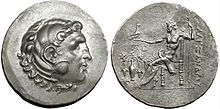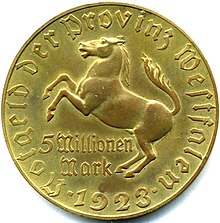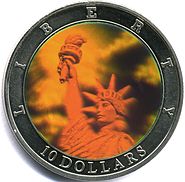Coin
Early metal coinage came into use about the time of the Axial Age in West Asia, in the Greek world, in northern India, and in China.[6] Coins were an evolution of "currency" systems of the Late Bronze Age, when various cultures used standard-sized ingots and tokens such as knife money to store and transfer value.Another example of local pride is the dispute about coinage, whether the first one to strike it was Pheidon of Argos, or Demodike of Kyme (who was wife of Midas the Phrygian and daughter of King Agammemnon of Kyme), or Erichthonios and Lycos of Athens, or the Lydians (as Xenophanes says) or the Naxians (as Anglosthenes thought).Many early Lydian and Greek coins were minted under the authority of private individuals and are thus more akin to tokens or badges than to modern coins,[20] though due to their numbers it is evident that some were official state issues.[6] Cyrus the Great introduced coins to the Persian Empire after 546 BC, following his conquest of Lydia and the defeat of its king Croesus, who had put in place the first coinage in history.With his conquest of Lydia, Cyrus acquired a region in which coinage was invented, developed through advanced metallurgy, and had already been in circulation for about 50 years, making the Lydian Kingdom one of the leading trade powers of the time.[28] Several of these issues follow the "western designs" of the facing bull heads, a stag, or Persian column capitals on the obverse, and incuse punch on the reverse.[28][29] According to numismatist Joe Cribb, these finds suggest that the idea of coinage and the use of punch-marked techniques was introduced to India from the Achaemenid Empire during the 4th century BC.This coin has a Greek legend reading phaenos emi sema[35] interpreted variously as "I am the badge of Phanes", or "I am the sign of light".The tyrants of Syracuse were fabulously rich, and part of their public relations policy was to fund quadrigas for the Olympic chariot race, a very expensive undertaking.Amongst the first centers to produce coins during the Greek colonization of Southern Italy (the so-called "Magna Graecia") were Paestum, Crotone, Sybaris, Caulonia, Metapontum, and Taranto.[43] Although many of the first coins illustrated the images of various gods, the first portraiture of actual rulers appears with the coinage of Lycia in the 5th century BC.[45] The Achaemenids had been the first to illustrate the person of their king or a hero in a stereotypical manner, showing a bust or the full body but never an actual portrait, on their Sigloi and Daric coinage from c. 500 BC.[45][46][47] A slightly earlier candidate for the first portrait-coin is Themistocles the Athenian general, who became a Governor of Magnesia on the Meander, c. 465–459 BC, for the Achaemenid Empire,[48] although there is some question as to whether his coins may have represented Zeus rather than himself.[49] Themistocles may have been in a unique position in which he could transfer the notion of individual portraiture, already current in the Greek world, and at the same time wield the dynastic power of an Achaemenid dynasty who could issue his own coins and illustrate them as he wished.The portraits "show a degree of individuality never matched by the often bland depictions of their royal contemporaries further West" (Roger Ling, "Greece and the Hellenistic World").Coinage followed Greek colonization and influence first around the Mediterranean and soon after to North Africa (including Egypt), Syria, Persia, and the Balkans.[43] Charlemagne, in 800 AD, implemented a series of reforms upon becoming "Holy Roman Emperor", including the issuance of a standard coin, the silver penny.[63] Variations in the mass of precious metals used in international trade, particularly in imports of spices and textiles into Europe, explain the numerous monetary reforms that occurred in this period.Faced with the distinct monetary systems developed by Genoa, Venice or Florence, the widespread use in the 15th century of the silver thaler, of constant size and mass, allowed conversion operations to be limited and therefore exchanges facilitated.The United States Mint, in an attempt to avoid this, implemented new interim rules on December 14, 2006, subject to public comment for 30 days, which criminalized the melting and export of pennies and nickels.This was more of a problem when coins were still made of precious metals like silver and gold, so strict laws against alteration make more sense historically.The United States is unusual in that it has only slightly modified its coinage system (except for the images and symbols on the coins, which have changed a number of times) to accommodate two centuries of inflation.Increases in the prices of copper, nickel, and zinc meant that both the US one- and five-cent coins became worth more for their raw metal content than their face (fiat) value.[75] Some convicted criminals from the British Isles who were sentenced to transportation to Australia in the 18th and 19th centuries used coins to leave messages of remembrance to loved ones left behind in Britain.A triangular coin with a face value of £5 (produced to commemorate the 2007/2008 Tutankhamun exhibition at The O2 Arena) was commissioned by the Isle of Man: it became legal tender on 6 December 2007.This is mathematically modeled as a finite-time singularity – the precession rate is accelerating to infinity, before it suddenly stops, and has been studied using high speed photography and devices such as Euler's Disk.The slowing down is predominantly caused by rolling friction (air resistance is minor), and the singularity (divergence of the precession rate) can be modeled as a power law with exponent approximately −1/3.Perspiration is chemically reduced upon contact with these metals, which causes the skin oils to decompose, forming with iron the volatile molecule 1-octen-3-one.Piloncitos have been unearthed from Mandaluyong, Bataan, the banks of the Pasig River, Batangas, Marinduque, Samar, Leyte and some areas in Mindanao."[85]The term "Piloncitos" is a contemporary word, used by modern-day antique collectors,[86] who thought that the cone-shaped pieces looked like a pilon of sugar.





















Coin (disambiguation)NumismaticsGlossaryCurrencyBanknotesForgeryCirculating currenciesLocal currenciesCompany scripTime dollarsFictional currenciesProposed currenciesHistory of moneyHistorical currenciesAksumiteAchaemenidByzantineChineseFilipinoIndianItalianJapaneseTibetanCoiningMillingHammeringMetalsErrorsCoin collectingCommemorative coinsBullion coinsGradingNotaphilyCommemorative banknotesExonumiaCredit cardsJetonsMedalsTokensChequesScripsScripophilyStockslegal tendergovernmentthe obverse and the reverseancient Greek worldHellenistic periodprecious metalbullioncoinage metalsbase metalfiat moneyface valueinflationGresham's lawcirculatingcoppersilverplatinumpalladiumBritish sovereignAmerican Gold EagleCanadian Gold Maple LeafKrugerrand2€ commemorative coinsAmerica the Beautiful quartersAxial AgeWest Asiaoxhide ingotLate Bronze AgeingotsAchaemenid EmpirebarterCentral Asiaknife moneyChinese Bronze AgeAnyangChinese currencycowrie"Bronze Shell"AlyatteselectrumPhanesIron Age AnatoliaTemple of Artemis at EphesusSeven Wonders of the Ancient WorldΠότνια ΘηρῶνAncient Greek coinageIonian GreeksHerodotusAristotlePolluxHermodike/Demodike of CymeAeoliaEphesusAlyattes of LydiaCroesusSardisbimetallic monetary systemCroeseidgold coinsAchaemenid coinageIllyrian coinageCyrus the Greatgold coinSiglosmonetary standardAchaemenid Persian EmpireAchaemenid conquest of the Indus ValleyCoinage of IndiaKabul valleyBhir MoundDarius IKabul hoardAfghanistanJoe CribbPushkalavatiGandharanpunch-marked coinsTaxilaGandharaArchaic period of ancient Greek coinagestaterSea turtleShaikhan Dehri hoard

